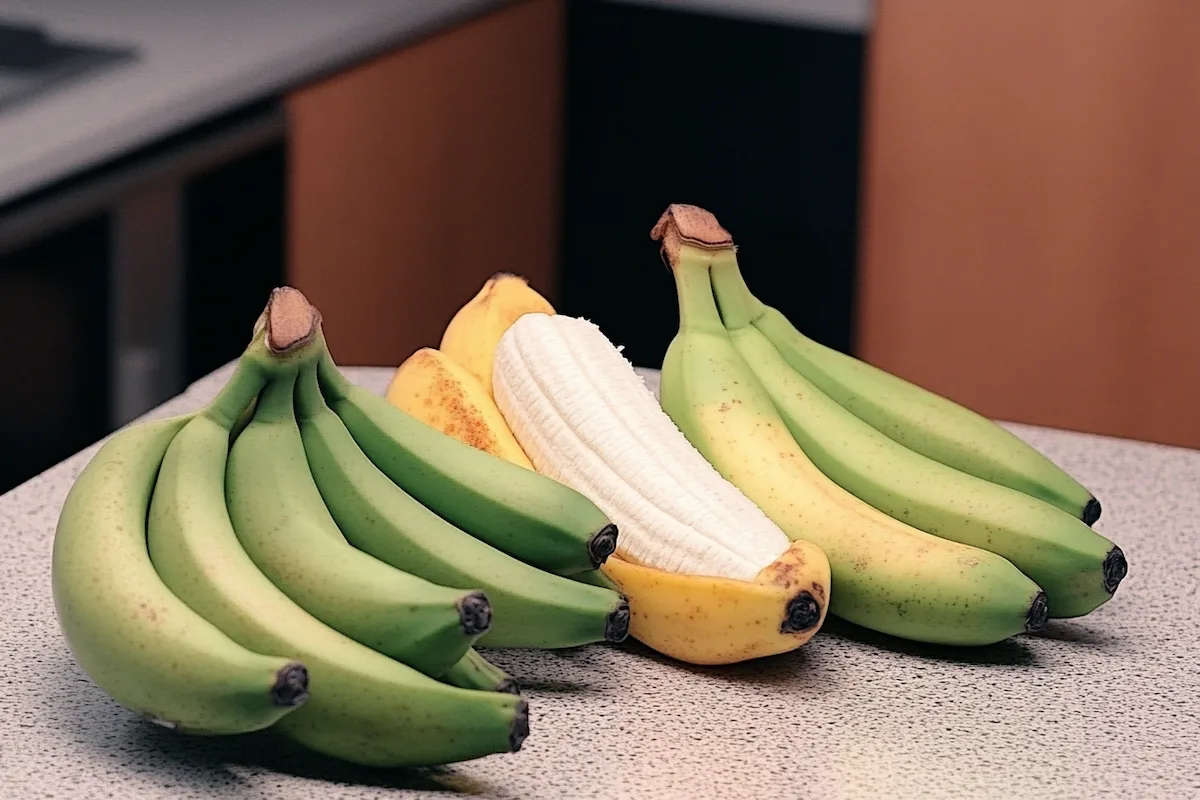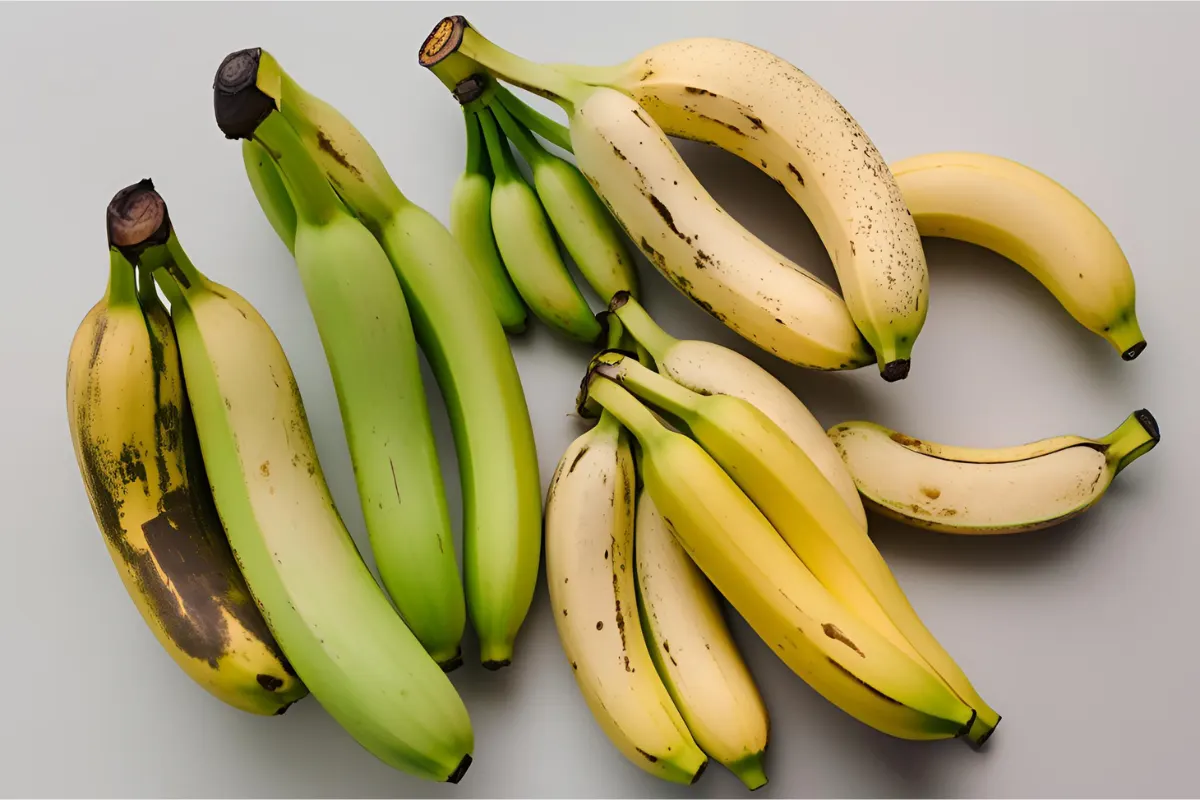Introduction
Bananas are beloved worldwide for their creamy texture and naturally sweet taste. However, not all bananas taste the same. Their sweetness, texture, and flavor depend on factors like ripeness, storage, variety, and temperature. If you’ve ever thought, “This banana tastes better,” those factors are at play. This article explores what enhances banana flavor and how to enjoy the best banana experience. By adjusting a few factors, you can improve the taste. Whether you love bananas daily or enjoy experimenting, this guide helps you get the most out of them.
What Enhances the Flavor of Bananas? Understanding the Role of Ripeness
How Ripening Affects the Flavor of Bananas
Ripeness plays the key role in enhancing banana flavor. Bananas start green and starchy, then convert starches into sugars as they ripen. This transformation makes bananas taste sweeter. Overripe bananas are often the sweetest. As they turn darker and spotted, the starches break down into sugars, creating a rich, sugary flavor.
A ripe banana has a smooth, mellow sweetness and soft texture. However, there’s a balance. If bananas ripen too much, they become mushy and overly sweet. The trick is to catch them at the right moment, with full flavor but not too mushy.
Not everyone likes fully ripe bananas. Some prefer bananas that are firmer and less sweet. These bananas are still partially green, with starches not fully converted. They taste more neutral and less sugary. To enhance banana flavor, consider the right ripeness. For subtle sweetness, choose bananas just past the green stage but not fully ripe.
Temperature and its Impact on Banana Ripening
Temperature plays a crucial role in enhancing banana flavor. Bananas should ripen at room temperature, but surrounding temperature matters. To speed up ripening, store bananas in a warm area. Avoid direct sunlight or heat, as they cause uneven ripening.
Refrigerating bananas can extend shelf life but affect flavor. Cold temperatures may darken the skin, though the fruit inside remains fine. The cool air slows starch conversion into sugars, leading to less flavor. For the best flavor, store bananas at room temperature. Once ripe, refrigerate them to preserve for later use.
The Sweet Spot: When Should You Eat Your Banana?
To enhance flavor, find the sweet spot when bananas are ripe enough to be sweet but not too mushy. A ripe banana, with golden yellow skin and small brown spots, is usually at its peak flavor. But don’t toss overripe bananas! They’re perfect for baking. Overripe bananas add caramelized sweetness to banana bread, muffins, or pancakes. You can also freeze them for smoothies, adding rich, creamy texture and natural sweetness without extra sugar.
Bananas require some trial and error to find the right ripeness. Whether snacking, baking, or blending, timing enhances your banana experience.
External Influences That Can Enhance Banana Flavor
Climate and Soil Quality’s Role
The environment where bananas grow greatly impacts their flavor. Bananas thrive in tropical and subtropical climates with warmth and humidity. Soil quality also plays a role, as it affects nutrient absorption, influencing the banana’s flavor. Bananas grown in rich, well-draining soils tend to be sweeter and more flavorful.
Bananas from tropical regions, like Central America, Africa, or Southeast Asia, are often sweeter. Consistent warm temperatures and long growing seasons allow slow ripening, developing deeper flavors. Bananas from temperate zones, where growing seasons are shorter and temperatures fluctuate, may taste less sweet. The cooler weather prevents slow ripening, making them starchier.
The high humidity in tropical climates affects banana texture and skin. Bananas from drier climates may have thicker skins, altering texture. Whether bananas come from tropical or temperate regions, their flavor is shaped by climate and soil. Each origin offers a unique flavor experience.
Ethylene Gas and Banana Flavor Enhancement
Ethylene gas is key to the ripening process of bananas and enhances their flavor. It’s a natural plant hormone. Ethylene accelerates the breakdown of starches into sugars, making bananas sweeter. The more ethylene bananas are exposed to, the faster they ripen. This is why bananas ripen faster near other fruits like apples, which release ethylene.
In commercial banana production, artificial ripening is common. Bananas are exposed to ethylene gas in controlled environments to speed up ripening. This method helps bananas reach the market at the right ripeness but can impact flavor. Rapid ripening can make bananas sweet but lacking in complex flavors.
When used correctly, ethylene gas helps bananas reach peak flavor more efficiently. At home, store bananas in a paper bag to trap ethylene. This speeds up ripening and enhances their sweetness. However, allowing bananas to ripen naturally usually results in a better, more refined flavor.
Improving Flavor through Banana Handling and Storage Tips
Banana Storage: Keeping Flavor at Its Peak
How you handle and store bananas can affect their flavor. Bananas are sensitive to temperature changes, so storage matters. Store bananas in a cool, dry place, away from direct sunlight. This helps them ripen slowly, preserving sweetness and texture. Proper storage keeps bananas firm and flavorful longer.
Avoid putting bananas in the fridge unless they’re overripe. Refrigeration can turn the skin dark brown or black, even if the fruit inside is fine. Cold temperatures slow down ripening, affecting the transformation of starches into sugars. This can result in a less flavorful banana. Refrigerate bananas only after they’re fully ripe to extend shelf life.
Improper handling can also cause flavor loss. If bananas are bruised or jostled, they may become mushy and develop off-flavors. Handle bananas gently, store them on a flat surface, and keep them at room temperature until ripe. This ensures they maintain their peak flavor and sweetness.
Using Natural Methods to Enhance Banana Flavor
If you’re looking to enhance the flavor of your bananas, there are several simple, natural methods you can try that don’t involve artificial processes. One of the most effective ways is to use brown paper bags to accelerate the ripening process. Bananas naturally emit ethylene gas, which is a key factor in ripening. By placing them in a paper bag, you trap the ethylene, which helps them ripen faster and more evenly. This method not only speeds up the ripening process but also ensures that the banana’s flavor profile develops fully, making them sweeter and more aromatic.
Another trick to enhance banana flavor is by pairing them with other fruits. Apples, for example, are known for their high ethylene production. Placing a banana in close proximity to an apple (or another ethylene-producing fruit) will increase the amount of gas around the banana, helping it ripen more quickly and enhancing the sweetness and richness of its flavor. This natural boost can help create that perfectly ripe banana, with an intensified flavor that makes for a truly enjoyable snack.
Moreover, keeping bananas in an area with consistent room temperature is essential. Avoid placing them in too warm or too cool environments. If you’re storing them in a room that’s too hot, they may ripen too quickly, losing their best flavors. On the other hand, if they’re stored too cool, they might ripen unevenly or too slowly. By making use of natural methods like the brown paper bag trick and the ethylene-boosting apple, you can create optimal conditions that enhance the natural flavors of your bananas without any added chemicals.
Banana Variety – A Key to Different Flavors
Cavendish vs Red Banana: The Flavor Showdown
When you think of bananas, chances are the first variety that comes to mind is the Cavendish. This banana is by far the most common variety found in grocery stores worldwide, prized for its smooth texture, consistent size, and sweetness. However, Cavendish bananas have a relatively mild flavor compared to some other varieties, which can be a bit too neutral for those looking for something with more depth and complexity. While they’re sweet and easy to enjoy, the flavor doesn’t pack quite the punch that some other types of bananas offer.
Enter the red banana, which stands in stark contrast to the Cavendish. With a reddish-purple skin and a slightly more robust flavor, red bananas are smaller, with a thicker flesh that is both creamier and less starchy. They tend to have a rich, honey-like sweetness with subtle hints of vanilla. The texture is also different—red bananas are more dense and creamy compared to the soft, smooth texture of Cavendish bananas. As a result, red bananas are not only sweeter but also offer a richer, fuller banana experience that many banana enthusiasts prefer for snacking or using in desserts.
In terms of flavor, red bananas are often considered a more exciting choice for those seeking a deeper, more complex banana taste. While Cavendish bananas have become the go-to variety due to their mass availability and neutral flavor, red bananas bring a refreshing twist to the typical banana experience, offering a unique alternative for those who want a more distinctive taste.
The Growing Popularity of Heirloom Banana Varieties
In recent years, heirloom banana varieties have gained popularity, with Blue Java bananas (also known as “ice cream bananas”) leading the way. These bananas are famous for their unique texture and flavor, often compared to vanilla ice cream. Unlike the Cavendish or red bananas, Blue Java bananas have a silvery-blue skin when ripe. Their flesh is creamy and sweet, with a complex flavor profile that includes hints of vanilla, coconut, and a delicate, sugary sweetness. People love using them for smoothies, desserts, or simply enjoying them fresh.
Heirloom bananas like Blue Java stand out for their diverse flavors. While Cavendish bananas are consistent, heirloom varieties offer unique taste profiles. These flavors vary slightly depending on the bananas’ growing location. Heirloom bananas are less commercially available but can be found at farmer’s markets or specialty grocers focused on sustainable or rare fruits.
As interest in different types of bananas grows, heirloom varieties provide a fresh, exciting way to experience bananas. They offer a greater depth of flavor and are a great alternative to the standard Cavendish banana. Often grown with more sustainable farming practices, heirloom bananas sometimes offer flavors that surpass the typical store-bought variety. For those seeking a new banana flavor experience, Blue Java and other heirloom varieties are game-changers.
FAQs
Does freezing bananas affect their flavor?
Yes, freezing bananas does impact their flavor, but often in a positive way. When bananas are frozen, their starches break down into sugars, resulting in a sweeter taste once thawed. This makes frozen bananas perfect for smoothies, desserts, or banana bread, as they add a natural sweetness and creamy texture. However, freezing bananas can also alter their texture, making them mushy when thawed. This is why frozen bananas are best used in recipes where texture isn’t as critical.
Can adding other fruits to bananas enhance their flavor?
Absolutely! Adding other fruits like apples, avocados, or citrus fruits to bananas can enhance their flavor. Apples, in particular, release ethylene gas, which can help speed up the ripening process and bring out the banana’s natural sweetness. Additionally, citrus fruits like oranges or lemons can balance the sweetness of bananas with a touch of acidity, creating a more complex flavor profile. So, experimenting with fruit combinations is a great way to elevate your banana experience.
Why do bananas taste different depending on where they are grown?
The taste of bananas can vary greatly depending on where they are grown due to environmental factors such as climate, soil quality, and growing methods. Bananas from tropical regions tend to be sweeter and more flavorful due to the consistent warmth and humidity. In contrast, bananas grown in temperate zones may not have as pronounced a sweetness because of the shorter growing seasons and fluctuating temperatures. Essentially, the climate and soil play a key role in determining how a banana’s flavor develops, giving bananas from different regions unique characteristics.
How do I store bananas to maintain their flavor longer?
To maintain the best flavor of bananas, store them in a cool, dry place at room temperature. Avoid refrigeration unless the bananas are already ripe, as cold temperatures can affect the ripening process and the flavor. For longer storage, consider placing bananas in a brown paper bag to trap ethylene gas, which will help them ripen evenly. Once ripe, you can refrigerate them to extend their shelf life, but note that this may darken the peel while preserving the fruit inside.
Can the banana peel influence the flavor?
The banana peel itself doesn’t directly impact the flavor of the fruit inside, but it plays a role in the overall banana experience. The peel serves as a protective layer, helping to maintain the flavor and texture of the banana by preventing it from bruising or being exposed to air, which can cause oxidation and off-flavors. Additionally, the ripeness of the peel often indicates the optimal flavor of the fruit inside—spotted or yellow peels usually mean the banana is at its peak flavor, while green peels indicate under-ripeness and less sweetness.
Should I use baking soda or powder in banana bread?
Baking soda is the preferred leavening agent for banana bread because it reacts with the acidity in mashed bananas, creating bubbles that help the bread rise. It also neutralizes the natural acidity in bananas, resulting in a more balanced flavor. While baking powder can work if your recipe calls for it, it may produce a slightly lighter texture. Both baking soda and baking powder can be used, but baking soda is generally the better choice for banana bread recipes.
Which is better for bread: baking soda or baking powder?
Baking soda is usually the better option for banana bread, as it reacts with the acid in the bananas to help the bread rise and improve texture. The reaction between baking soda and the acidic elements in the banana helps achieve a denser, moist loaf, which is ideal for banana bread. Baking powder, on the other hand, is a leavening agent that works well in recipes without acidic ingredients. In banana bread, baking soda is the go-to for best results.
Does it matter if I use baking powder or baking soda?
Yes, it does matter whether you use baking powder or baking soda in banana bread. Baking soda is more effective when paired with acidic ingredients like bananas, while baking powder is used in recipes without acids. In banana bread, baking soda interacts with the acidity in the fruit, resulting in a richer flavor and better rise. Using the wrong leavening agent can affect the texture and flavor of your bread, so it’s important to follow the recipe instructions to ensure you get the best banana bread experience.
Conclusion
In conclusion, enhancing banana flavor depends on understanding key factors that affect taste. Ripeness, variety, storage, and climate matter. Each element plays a crucial role in banana sweetness and flavor. Whether you prefer Cavendish sweetness or the richness of a red banana, you can experiment to find your ideal flavor. Next time you grab a banana, consider how its ripeness, storage, or variety can unlock a new level of deliciousness.


